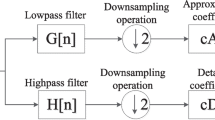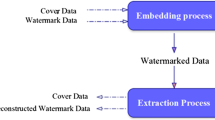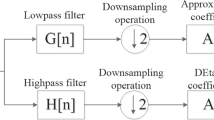Abstract
Wireless communication technology, which provides voice communication and high pick data rates for Orthogonal Frequency Division Multiplexing (OFDM) systems, have been investigated in the article. The Fast Fourier transform (FFT) and the 2D discrete wavelet transform (2D-DWT) were applied for this investigation. The design of scrambling system consists from three parts, namely from the transmitter, the receiver and the noisy channel. The efficiency results for two cases (normalized and non-normalized) of both transforms (FFT and 2D-DWT) in OFDM system were calculated using the program inMATLABsoftware. The comparison of systems in a fadingAWGNchannel was carried out.
Similar content being viewed by others
References
Laith A. Abdul-Rahaim, “Proposed realization of modified scrambling using 2D-DWT based OFDM transceivers,” MASAUM J. Comput. 1, No. 2, 245 (Sept. 2009).
Md. Sipon Miah, M. Mahbubur Rahman, T. K Godder, Bikash Chandra Singh, M. Tania Parvin, “Performance comparison of AWGN, flat fading and frequency selective fading channel for wireless communication system using 4QPSK,” Int. J. Comput. Inf. Technol. 1, No. 2, 81 (2011).
Chau Vo, Fading Channel Characterization and Modeling (California State University, Northridge, Dec. 2012).
M. B. Veena, M. N. Shanmukha Swamy, “Performance analysis of DWT based OFDM over FFT based OFDM and implementing on FPGA,” Int. J. VLSI design & Commun. Syst. 2, No. 3, 119 (Sept. 2011), DOI: 10.5121/vlsic.2011.2310.
Fabio Belloni, Fading Models. S-72.333. Postgraduate Course in Radio Communications (Autumn 2004).
Dapeng Wu, Rohit Negi, “Effective capacity channel model for frequency-selective fading channels,” in Proc. of Second Int. Conf. on Quality of Service in Heterogeneous Wired/Wireless Networks, 24 Aug. 2005, Lake Vista, FL (IEEE, 2005), p. 43, DOI: 10.1109/QSHINE.2005.20.
Al-Shuraifi Mushtaq, Al-Anssari Ali Ihsan, Mikhail Reznikov, “FRAT-OFDM vs. FFT-OFDM Systems in Fading AWGN Channels,” Electronics and Communications, 19, No. 2, 53 (2014), http://ela.kpi.ua/bitstream/123456789/ 10140/1/8.pdf.
Mohd Al Hafiz Bin Osman, “Modelling Rayleigh fading propogation and effect in wireless communication channel using Matlab,” Report of Faculty of Electronic and Computer Engineering. TK5103.2.M46 (University Teknikal Malaysia, 2008).
Radomir S. Stankovic, Bogdan J. Falkowski, “The Haar wavelet transform: its status and achievements,” Comput. Electrical Eng. 29, No. 1, 25 (Jan. 2003), DOI: 10.1016/S0045-7906(01)00011-8.
Author information
Authors and Affiliations
Corresponding authors
Additional information
Original Russian Text © Al-S. Mushtaq, Al-A. A. Ihsan, N. Qasim, 2015, published in Izv. Vyssh. Uchebn. Zaved., Radioelektron., 2015, Vol. 58, No. 5, pp. 50–57
About this article
Cite this article
Mushtaq, AS., Ali Ihsan, AA. & Qasim, N. 2D-DWT vs. FFT OFDM Systems in fading AWGN channels. Radioelectron.Commun.Syst. 58, 228–233 (2015). https://doi.org/10.3103/S0735272715050052
Received:
Published:
Issue Date:
DOI: https://doi.org/10.3103/S0735272715050052




